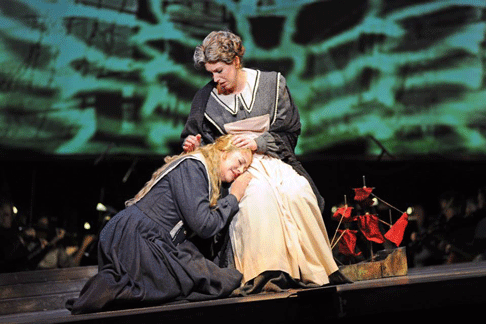On November 15, 2013, Arizona Opera celebrated Richard Wagner’s two hundredth birthday with a new production of his first success, The Flying Dutchman (Der Fliegende Holländer). Wagner was inspired to write this opera after he fled from Riga where his creditors were hot on his trail. While conducting at the court theater there, he and his first wife, Minna, had run up huge debts. When he lost the job, there was no way he could pay. The court confiscated their passports but they escaped the debt collectors by illegally crossing the border into Prussia. There they boarded a ship for an eight-day passage to London. They encountered terrible storms and high winds which forced their sailing ship to endure a three-week rollercoaster ride as its captain sought shelter along the coast of Norway. The stormy seas made the composer think of Nordic legends, one of which was the story of the Dutchman who could only return to land once in seven years.
Later he wrote: "The voyage through the Norwegian reefs made a wonderful impression on my imagination; the legend of The Flying Dutchman, which the sailors verified, took on a distinctive, strange coloring that only my sea adventures could have given it.” Several of Wagner’s protagonists were men who lived outside of society. Not only does the Dutchman materialize out of the ether, so does Lohengrin. The Dutchman is a wanderer and so are Siegmund, Tannhäuser, and Wotan. The Flying Dutchman was a seminal opera for him.
This opera requires a large orchestra that would not fit in the Phoenix Symphony Hall pit. Since Arizona Opera wanted to use the full complement of musicians, the players were at the back of the stage and the action was mounted on flooring built over the orchestra pit. It brought the singers much closer to the audience and all the overtones and colors in their voices were easily heard. Director Bernard Uzan gave us a realistic interpretation of the story while Peter Dean Beck’s platforms and props made it come to life with the help of this most capable cast. Most of the scenery consisted of Douglas Provost’s visually piquant projections, which included nautical images by Gustave Doré, one of Wagner’s favorite artists. The projection seen upon entry contained portraits of Wagner and Doré.
With the stage in this arrangement, there could be no curtain, so after the overture, Daland, Raymond Aceto, strode onstage from the wings to ask the Steersman to take the next watch. Aceto has a magnificent bass sound and it was all the more evident with him in front of the orchestra. For the Steersman, Christian Reinert, it was not a good thing. He had trouble reaching his high notes and there was no orchestral cover to hide any of it.

Baritone Mark Delavan was a passionate Dutchman whose cavernous voice surged out over the audience with tonal opulence. A powerful Senta, Lori Phillips’ bright sound energized the text and made her rendition exciting. She is just beginning to emerge as a true dramatic soprano but she is already singing with a distinctively colored sound. It has been many years since a soprano brought as much exhilaration to this role as Phillips did on Saturday night.
Corey Bix was a credible Eric who would have made Senta a good husband had she not been infatuated with the Dutchman and his legend. Young artist program member, Beth Lytwynec showed her ability as a character actress with her portrayal of Senta's work supervisor, Mary, as an old woman. Her singing showed her sonorous, youthful voice, however. Henri Venanzi’s chorus was relegated to a slightly raised area behind the orchestra so they could not move about freely. Although they did perform some dance movements, they made their part clear with robust singing. Conductor Joseph Resigno's lyrical interpretation of this early Wagner score brought out its relationship to the nineteenth century operas that preceded it. His players responded with an exciting rendition that helped make this one of the best performances heard recently at Arizona Opera.
Maria Nockin
Cast and production information:
The Dutchman, Mark Delavan; Daland, Ramond Aceto; Senta, Lori Phillips; Erik, Corey BIx; Steersman, Christian Reinert; Mary, Beth Lytwynec; Director, Bernard Uzan; Conductor, Joseph Resigno; Chorus Master, Henri Venanzi; Lighting and Projection Design, Douglas Provost; Scenery and Props, Peter Dean Beck.

